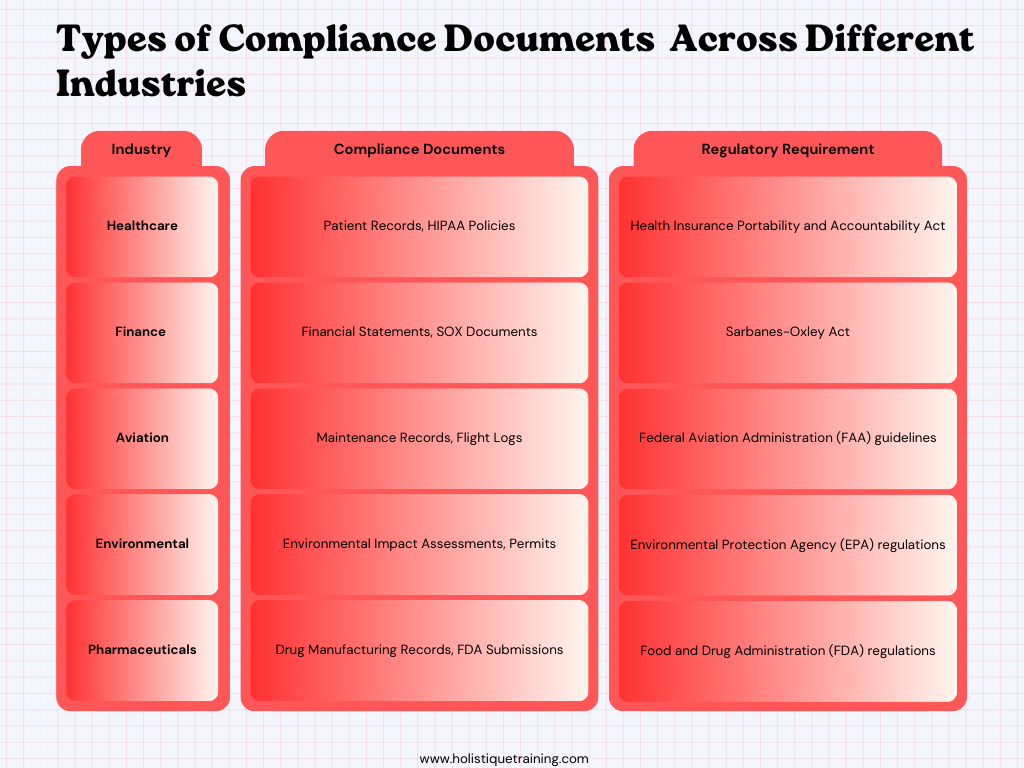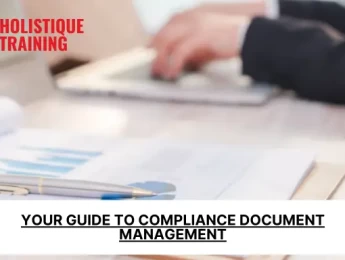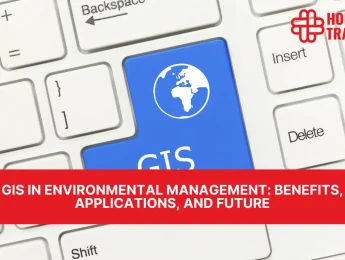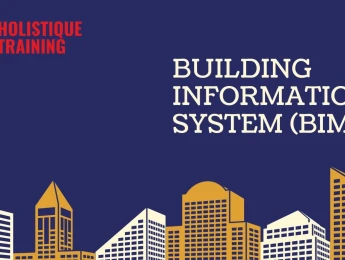- Table of Contents
- Introduction
- What Is Compliance Document Management?
- Document Compliance Manager Responsibilities
- 1. Regulatory Navigation and Interpretation
- 2. Policy Development and Implementation
- 3. Audit Preparation and Facilitation
- 4. Documentation Training and Awareness
- 5. Record Maintenance and Archiving
- 6. Risk Assessment and Mitigation
- Why Is Compliance Document Management Important?
- Legal Adherence and Avoidance of Penalties
- Risk Mitigation and Proactive Management
- Reputational Integrity and Trust Building
- Operational Efficiency and Informed Decision-Making
- Contractual and Legal Safeguards
- Continuous Improvement and Adaptability
- Compliance Document Management Procedure
- 1. Document Identification
- 2. Classification and Categorisation
- 3. Version Control
- 4. Secure Storage
- 5. Access Control and Permissions
- 6. Retention and Disposal Policies
- 7. Regular Audits and Updates
- 8. Training and Awareness Programmes
- Compliance Document Management: Mistakes to Avoid
- 1. Lack of Documentation Ownership
- 2. Inadequate Training and Awareness
- 3. Ignoring Digital Security Measures
- 4. Neglecting Document Disposal Protocols
- 5. Failure to Regularly Update Policies
- 6. Disorganised Record-Keeping
- Utilising Technology in Compliance Document Management
- Document Management Software
- Blockchain Technology
- Artificial Intelligence and Machine Learning
- Mobile Accessibility
- Conclusion
Introduction
Welcome to the digital age, where businesses thrive on data and information. Managing compliance documents has become more critical than ever before in this vast landscape of digitised documents and regulatory complexities. Compliance document management is the systematic process of organising, storing, and tracking various documents to ensure adherence to legal, industry, and organisational standards. Let's embark on a journey to unravel the intricate tapestry of compliance document management, exploring its essence, importance, procedures, responsibilities, pitfalls, and the transformative power of technology in this realm.
What Is Compliance Document Management?
At its core, compliance document management is the heartbeat of any organisation's legal and operational framework. It involves efficiently handling a myriad of documents such as contracts, policies, licences, and certifications, ensuring they align with the industry's relevant regulations and guidelines. This multifaceted discipline demands meticulous attention to detail, a keen understanding of regulations, and an unwavering commitment to maintaining the integrity of organisational records.
Document Compliance Manager Responsibilities
In the realm of compliance document management, the role of a Document Compliance Manager emerges as pivotal. This professional is entrusted with a diverse set of responsibilities, including:
1. Regulatory Navigation and Interpretation
One of the foremost responsibilities of a Document Compliance Manager is to stay abreast of the constantly evolving regulatory landscape. This means understanding the existing laws and standards and proactively tracking updates, amendments, and new regulations that might impact the organisation. This individual needs to interpret these regulations and translate them into practical actions for the organisation.
For instance, in the healthcare sector, a Document Compliance Manager must understand the intricacies of the Health Insurance Portability and Accountability Act (HIPAA) and ensure that all patient-related documents, from medical records to billing information, comply with HIPAA's stringent privacy and security rules.
2. Policy Development and Implementation
Document Compliance Managers often play a crucial role in crafting and updating internal policies and procedures related to document management. These policies must align with both external regulations and the organisation's unique needs. Such policies might cover document creation, storage, access control, retention periods, and disposal.
For instance, in a financial institution, these policies might need to adhere to regulations like the Sarbanes-Oxley Act (SOX), which mandates strict record-keeping and document retention rules. The Document Compliance Manager must develop policies ensuring the organisation's financial records meet these requirements.
3. Audit Preparation and Facilitation
When regulatory authorities or third-party auditors come knocking, the Document Compliance Manager must ensure a seamless audit process. This involves assembling all necessary documents, ensuring they are well-organised, and facilitating the audit itself. Moreover, the manager must be ready to address any questions or concerns the auditors might have.
In the context of the pharmaceutical industry, for example, Good Manufacturing Practices (GMP) audits are commonplace. The Document Compliance Manager in such a setting must ensure that the necessary records, including batch records and quality control documents, are readily accessible and meet the stringent requirements of GMP.
KPI | Description | Importance |
Document Accuracy Rate | Percentage of accurate documents maintained | Ensures integrity of compliance data |
Compliance Audit Success | Percentage of successful compliance audits | Reflects adherence to regulations |
Document Retrieval Time | Average time taken to retrieve documents | Measures operational efficiency |
Compliance Training Hours | Hours of training provided on compliance | Indicates workforce awareness |
Regulatory Compliance Score | Score assessing alignment with regulations | Quantifies compliance effectiveness |
Table 1: Key Performance Indicators (KPIs) for compliance document management
4. Documentation Training and Awareness
A Document Compliance Manager's often overlooked but critical role is conducting training and awareness programmes for the organisation's staff. Ensuring all employees, from top management to front-line workers, understand the importance of compliance and the specific document management protocols is essential.
In a highly regulated sector like aviation, for instance, the Document Compliance Manager must educate staff on maintaining maintenance, repair, and inspection records. This could involve training on procedures to document aircraft maintenance and adhere to the Federal Aviation Administration (FAA) requirements.
5. Record Maintenance and Archiving
The day-to-day upkeep of compliance documents is also a core responsibility. Document Compliance Managers must oversee records maintenance, organisation, and archiving. This includes implementing effective document management systems that allow for easy retrieval and monitoring of document versions.
For instance, in the legal field, the manager would be responsible for maintaining case files, contracts, and legal opinions. These documents must be stored securely, and a reliable system for version control should be in place to track changes over time.
6. Risk Assessment and Mitigation
Beyond the routine management of documents, a Document Compliance Manager should be vigilant in identifying potential risks and vulnerabilities. They need to assess how compliance documents can be exposed to legal and operational risks, such as data breaches or document tampering, and take proactive steps to mitigate these risks.
In the cybersecurity sector, the manager might need to ensure compliance with the General Data Protection Regulation (GDPR). This entails assessing data processing procedures, documenting the legal basis for data processing, and implementing measures to safeguard personal data from breaches.
In essence, the role of a Document Compliance Manager is a blend of legal acumen, project management skills, and a deep understanding of the specific regulations governing the industry. They are the guardians of an organisation's compliance document ecosystem, ensuring that it meets current standards and is adaptable to the ever-changing regulatory landscape. This role is not just about managing paperwork; it's about safeguarding an organisation's legal and operational integrity.
Why Is Compliance Document Management Important?
Compliance document management is a shield in the fast-paced business landscape, safeguarding organisations from legal liabilities and reputational risks. Here's why it holds paramount importance:
Legal Adherence and Avoidance of Penalties
Compliance document management ensures that an organisation adheres to a myriad of laws and regulations, both at the national and international levels. This adherence is not just a best practice but a legal requirement. Failure to comply with regulations can result in severe penalties, fines, lawsuits, and even imprisonment for individuals involved. For instance, non-compliance with regulations like the Dodd-Frank Act can lead to substantial financial penalties in the financial sector.
Risk Mitigation and Proactive Management
Comprehensive compliance document management enables organisations to effectively identify, assess, and mitigate risks. By maintaining accurate and up-to-date records, businesses can foresee and proactively address potential compliance issues. This proactive approach helps avoid legal disputes, financial losses, and reputational damage. For instance, in the healthcare industry, proper management of patient records mitigates the risk of medical malpractice lawsuits and regulatory fines.
Reputational Integrity and Trust Building
A strong compliance document management system fosters trust and confidence among clients, partners, shareholders, and the public. When stakeholders are assured that the organisation operates within the bounds of the law, it enhances the company's reputation. Trust is a valuable currency in business, and organisations with a reputation for compliance and ethical conduct attract more customers and partners. This is particularly vital in industries such as pharmaceuticals, where consumers need assurance regarding the authenticity and safety of products.
Operational Efficiency and Informed Decision-Making
Efficient management of compliance documents streamlines internal operations. When employees can quickly access relevant documents, decision-making processes are expedited. Managers can make informed choices based on accurate data, leading to more efficient workflows. This agility is invaluable in fast-paced sectors like technology, where rapid decision-making can determine a company's competitive edge.
Contractual and Legal Safeguards
Compliance document management is essential for effectively managing contracts and agreements. By maintaining comprehensive records of contracts, organisations can ensure that all parties fulfil their obligations. In disputes, well-documented agreements can protect the organisation legally and financially. In industries such as construction, where contracts are complex and involve multiple stakeholders, meticulous document management is indispensable.
Continuous Improvement and Adaptability
Compliance document management isn't static; it's a dynamic process that evolves with changing regulations and organisational needs. Through regular audits and assessments, organisations can identify areas for improvement and adapt their document management protocols accordingly. This continuous improvement ensures that the organisation complies with new laws and standards. Adaptability is key to compliance in sectors like environmental conservation, where regulations are continually evolving.
Compliance document management is the cornerstone of organisational integrity, legal adherence, and sustainable growth. It empowers businesses to navigate the intricate web of regulations, mitigate risks, build trust, and make informed decisions. As businesses continue to operate in an increasingly regulated world, investing in robust compliance document management isn't just a choice; it's a strategic imperative that can define an organisation's success and longevity.
Compliance Document Management Procedure
Establishing a robust compliance document management procedure is akin to crafting a masterpiece – it requires precision, dedication, and attention to detail. Here's a step-by-step guide to crafting an effective procedure:
1. Document Identification
The first step in the procedure involves identifying the various types of documents relevant to the organisation's operations. This includes contracts, licences, certifications, policies, financial records, and any other documents necessary for regulatory compliance. A thorough audit of existing documents ensures that nothing essential is overlooked.
2. Classification and Categorisation
Once documents are identified, they need to be classified and grouped based on their nature and importance. Documents can be classified into groups such as legal documents, financial records, operational policies, and client contracts. Each category should have specific classification criteria, making it easier for employees to understand the importance and relevance of each document.
3. Version Control
Implementing a robust version control system is crucial to tracking document revisions accurately. Each document version should be clearly labelled, indicating the date of creation or modification and the changes made. Maintaining a detailed version history is essential for auditing purposes and ensuring that the most recent version of a document is always in use.
4. Secure Storage
Choosing the right storage solution is paramount for compliance document management. Organisations can opt for secure digital platforms or physical storage systems, depending on the nature of their documents. Digital platforms should offer encryption, secure access controls, and regular security audits to protect sensitive information from unauthorised access and cyber threats. Physical documents should be stored in locked cabinets or rooms with limited access.
5. Access Control and Permissions
Access control mechanisms are implemented to restrict document access to authorised personnel only. Document Compliance Managers need to define user roles and permissions, ensuring that employees can access only the documents necessary for their specific roles. Regular reviews of access permissions are conducted to prevent unauthorised access and maintain data integrity.
6. Retention and Disposal Policies
Establishing clear retention policies is essential to determine how long documents should be kept. Compliance requirements and industry standards often dictate retention periods. Once a document reaches the end of its retention period, it should be disposed of securely. For physical documents, shredding or incineration ensures complete destruction, while digital files should be permanently deleted using secure deletion methods.
7. Regular Audits and Updates
Regular internal audits of compliance documents are a proactive approach to ensuring adherence to regulations. Audits verify that documents are up-to-date, accurately classified, and stored securely. Any discrepancies or non-compliance issues identified during audits should be addressed promptly. Additionally, the compliance document management procedure should be periodically reviewed and updated to align with new regulations or changes in organisational structure.
8. Training and Awareness Programmes
Educating employees about compliance document management procedures and best practices is crucial. Training programmes should cover topics such as document creation guidelines, version control protocols, and secure storage practices. By fostering a culture of compliance, employees become proactive in adhering to document management procedures, reducing the risk of inadvertent errors.
By following this comprehensive compliance document management procedure, organisations can ensure that their document management practices are efficient and compliant with legal and regulatory requirements. A well-organised and secure document management system mitigates risks, enhances the organisation's reputation, instils trust among stakeholders, and provides a solid foundation for sustainable growth.
Compliance Document Management: Mistakes to Avoid
While compliance document management is crucial, several pitfalls can derail even the most well-intentioned efforts. Here are some common mistakes to avoid:
1. Lack of Documentation Ownership
One of the most significant mistakes is not assigning specific ownership to documents. Each document should have a designated owner within the organisation responsible for its accuracy, integrity, and compliance. Without clear ownership, documents can fall through the cracks, leading to inconsistencies, outdated information, and non-compliance issues.
To avoid this, organisations should establish a clear document ownership hierarchy. Document Compliance Managers should work closely with department heads to ensure every document has a responsible owner who oversees its management, updates, and adherence to compliance standards.
2. Inadequate Training and Awareness
Insufficient training and awareness programmes can lead to employees mishandling documents, inadvertently violating compliance protocols. Lack of understanding regarding the importance of compliance, document categorisation, version control, and disposal procedures can result in errors.
To mitigate this, organisations must invest in comprehensive training sessions. Regular workshops, online modules, and awareness campaigns can educate employees about compliance regulations, document management protocols, and the potential consequences of non-compliance. Periodic refresher courses can reinforce this knowledge among the workforce.
3. Ignoring Digital Security Measures
With documents increasingly digitised, overlooking digital security measures is a significant mistake. Failing to implement robust encryption, secure access controls, and regular security audits can leave digital documents vulnerable to cyber threats and unauthorised access.
To address this, organisations should prioritise digital security. Encryption algorithms, multi-factor authentication, and secure cloud storage services ensure the confidentiality and integrity of digital documents. Regular security audits and timely software updates are essential to staying ahead of evolving cybersecurity threats.
4. Neglecting Document Disposal Protocols
Improper document disposal, whether physical or digital, is a common pitfall. Outdated or unnecessary documents that are not disposed of securely can still be accessed, leading to compliance breaches. Neglecting document disposal protocols can result in legal liabilities and data breaches.
Organisations should establish clear guidelines for document disposal. Physical documents should be shredded or incinerated, ensuring complete destruction. Digital files should be permanently deleted using secure deletion methods that overwrite data to prevent recovery. Regular audits should verify the proper implementation of disposal procedures.
5. Failure to Regularly Update Policies
Compliance regulations and industry standards are constantly evolving. Failing to update internal policies and procedures accordingly can lead to non-compliance. Outdated policies may not align with current regulations, putting the organisation at risk.
To prevent this mistake, organisations should establish a policy review schedule. Regular reviews, ideally conducted annually or whenever there is a significant regulatory change, ensure that internal policies remain current and in compliance with the latest standards. Document Compliance Managers should collaborate with legal experts to stay informed about regulatory updates and make necessary policy revisions promptly.
6. Disorganised Record-Keeping
Disorganised record-keeping can lead to chaos when auditors or regulatory authorities request specific documents. The inability to locate documents promptly can result in delayed responses, fines, and reputational damage.
Implementing a systematic approach to document organisation is vital. Utilising document management software with advanced search capabilities, metadata tagging, and intuitive folder structures can streamline document retrieval. Regularly updating indexes and ensuring all documents are appropriately labelled facilitate efficient record-keeping.
By avoiding these common mistakes, organisations can establish a robust compliance document management system that meets legal requirements, enhances operational efficiency, and reduces the risk of compliance breaches. A proactive approach, comprehensive training, regular audits, and meticulous attention to detail are key to building a resilient compliance document management framework.
Utilising Technology in Compliance Document Management
Embracing technology has revolutionised the landscape of compliance document management, making processes more efficient, secure, and streamlined. Here's how technology is reshaping this critical domain:
Document Management Software
Document management software is the backbone of modern compliance document management systems. These platforms provide a centralised digital space for storing, organising, and accessing documents. They offer features such as version control, access permissions, document categorisation, and advanced search functionalities. Document Compliance Managers can easily track document revisions, ensure compliance with regulatory requirements, and streamline document retrieval during audits. Statistics show that the document management system market is poised for substantial growth, with a projected value of $11.47 billion by 2026. From 2020 to 2026, it is anticipated to maintain a strong Compound Annual Growth Rate (CAGR) of 13.05%.
These software solutions' intuitive interfaces make it easier for employees to upload, edit, and collaborate on documents. Furthermore, automated workflows can be implemented to route documents for approvals and signatures, reducing manual intervention and ensuring consistency in compliance procedures.
Blockchain Technology
Blockchain technology has emerged as a game-changer in ensuring the integrity and authenticity of compliance documents. By leveraging blockchain, organisations create a tamper-proof, decentralised ledger where documents are stored securely and transparently. Once a document is recorded on the blockchain, it cannot be altered or deleted, providing an immutable record of its history.
This technology is particularly valuable for industries where document tampering or fraud is a significant concern, such as in legal, financial, or real estate sectors. For instance, in real estate, property records stored on a blockchain ensure their accuracy and prevent fraudulent activities related to property ownership.
Artificial Intelligence and Machine Learning
Artificial intelligence (AI) and machine learning (ML) algorithms are being increasingly utilised to automate various aspects of compliance document management. These technologies can analyse vast amounts of data, extract relevant information from documents, and validate their accuracy. Natural Language Processing (NLP) algorithms can understand the context within documents, making it easier to categorise and archive them properly.
AI and ML also facilitate predictive analytics, allowing organisations to anticipate compliance requirements based on historical data and industry trends. Predictive analytics help in proactive decision-making, enabling organisations to stay ahead of regulatory changes and adjust their compliance strategies accordingly.
Mobile Accessibility
Mobile applications and platforms have revolutionised the way employees interact with compliance documents. Mobile accessibility allows authorised personnel to access important documents securely from their smartphones or tablets, irrespective of their location. This flexibility enhances collaboration among remote teams, field workers, and travelling executives, ensuring they can refer to necessary documents on-the-go.
Mobile apps often come with user-friendly interfaces, making it easy for employees to search for documents, view updates, and even sign digital contracts while away from the office. This mobility fosters real-time collaboration and ensures that compliance documents are accessible whenever and wherever they are needed.
Incorporating these technological advancements into compliance document management enhances efficiency and strengthens the organisation's overall compliance posture. Document Compliance Managers are pivotal in evaluating and selecting the right technologies, ensuring seamless integration, and training employees on their effective use. By embracing these technologies, organisations can meet compliance requirements more effectively and gain a competitive edge by being agile, secure, and adaptive in the face of ever-changing regulatory landscapes.
Conclusion
Compliance document management is not merely a task but a strategic imperative for organisations aiming to successfully navigate the complex terrain of regulations and standards. By embracing the responsibilities of document compliance managers, understanding the significance of compliance management, following meticulous procedures, avoiding common mistakes, and leveraging cutting-edge technology, businesses can unlock a world of opportunities while safeguarding their integrity and reputation.
In this digital era, where information reigns supreme, mastering the art and science of compliance document management is the key to unlocking the doors of sustainable success and unparalleled growth. Elevate your organisation's compliance prowess and set it on the path to excellence by enrolling in our course, ‘Understanding Record & Document Management for Your Business.’ Discover the strategies, tools, and expertise needed to navigate the regulatory landscape and achieve unrivalled success confidently. Don't miss this opportunity to propel your business to new heights! Enrol now or contact us for more information.
























